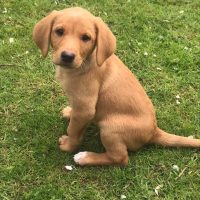 Bringing a new puppy home is a very exciting time but it’s also important to aim to set the environment up for success from the start, with the aim of preventing potential problems from developing. Young puppies are amazingly versatile – in the space of a few hours they have to experience:
Bringing a new puppy home is a very exciting time but it’s also important to aim to set the environment up for success from the start, with the aim of preventing potential problems from developing. Young puppies are amazingly versatile – in the space of a few hours they have to experience:
– Being separated from their siblings, mum, familiar people and possibly other familiar dogs.
– Being taken away from their familiar environment & scent profile and put into an alien one.
– A car journey with unfamiliar people.
– Introductions to new pets.
– Being introduced to a collar (and lead).
– A new bed/crate.
– A new routine.
Good genes, a good breeder/rearing environment, and the sensitive period for socialisation will help the puppy take it all in their stride but there are lots of ways to make the experience as easy as possible for them:
– Puppy pens can be useful for introductions to existing dogs, which should generally be done in the garden with 2 people to make it easier. Adult dogs should be calm and communicate to the puppy with subtle body language rather than harsh discipline. Equally the puppy should not learn they can interact with co-habiting adult dogs inappropriately. If either of these scenarios are possible, make introductions slow, managed appropriately and always supervised to prevent rehearsal of the unwanted behaviours. Be aware that some existing dogs may need more time to adjust to the new arrival than others. An adult dog choosing to ignore the puppy is a sign they are not comfortable with interacting, so ensure you prevent the puppy from approaching so that the adult dog does not escalate their behaviour towards the puppy.
– Feed all meals in the puppies bed/area to create a positive association.
– Create a safe area for the puppy, consisting of a choice of beds, items to chew on and play with, and different surfaces/textures to walk over. It shouldn’t look tidy. Lots of feeding experiences in this space.
– An Adaptil Junior collar can be placed on the puppy if they are used to wearing an ID collar with the breeder, otherwise a diffuser in their safe area may be preferable until the puppy has been introduced to a collar. Adaptil mimics the pheromones produced by the mum that makes the puppies feel safe, secure and calm, and this can help your puppy settle into its new environment.
– Consider sleeping with your puppy until they have fully settled into their new environment and you have built up some separation during the daytime. Leaving puppy to cry on their own can lead to extreme distress during an already stressful period, and/or learning that vocalising/scratching makes people appear which can have implications for separation-related behaviour.
– Exposure to other animals the puppy will interact with regularly throughout their lives is important in a controlled manner so that both the puppy and other animals remain relaxed at all times. Give the puppy as much space as possible so that they can process information in their own time.
– Carry your puppy to expose them to life outside the house/garden.
– Give them LOADS of opportunity to sleep. Moving to a new home is EXHAUSTING. Their brains and bodies are growing at an exponential rate. Sleeping puppies should be left alone.
– Take time to build a relationship: Reinforce all behaviours you want to see more of using praise, food, toys, touch or anything else your puppy enjoys. Pre-empt all unwanted behaviours as much as possible e.g. puppy proof the house and garden so pup cannot access anything potentially valuable/dangerous. Redirect your puppy from any unwanted behaviours e.g. picking up items you don’t want puppy to have; play biting/mouthing.
There’s a lot of socialising we can do safely prior to completing puppy vaccinations and it is vital that we don’t waste any time within their sensitive period of development, whilst allowing them loads of time to rest. Some examples:
– Short car journeys (set up so the puppy is relaxed in the car).
– Dog friendly coffee shops – take the puppy’s own mat.
– Visitors (instructed to leave the puppy when they are sleeping).
– Carried to observe traffic and other external stimuli.
– Introductions to known, even-tempered, fully vaccinated adult dogs in gardens.
– Scent boxes brought into the home of the outside world – feathers, leaves, cloths of cat/horse/chicken scents.
– Novel items for your puppy to play with, explore, walk on, sleep on, chew on etc.